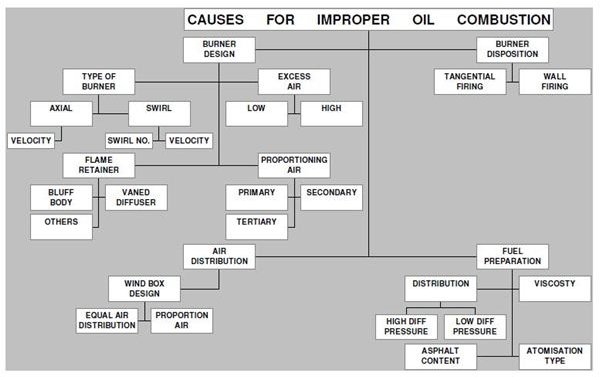Analyze Poor Oil Gun Performance in Boilers
Oil guns are in coal and oil fired boilers. In coal fired boilers the oil guns are used for start-up and warm-up purpose. These oil guns are designed with a capacity of around thirty percent of boiler maximum continuous rating. They are used for starting coal mills and as coal flame stabilization fuel. In oil fired boilers, with the main fuel being oil, they do all the functions of start-up, warm-up and load carrying. The oil gun performance can be poor due to oil quality, combustion, mechanical parts of the oil gun, and air distribution for the oil guns.
Causes for improper combustion
- Burner design
- Type of burner
- Axial
- Velocity
- Axial
- Swirl
- Swirl number
- Velocity
- Type of burner
- Flame retainer
- Bluff body
- Vane diffuser
- Others
- Proportioning of air
- Primary
- Secondary
- Tertiary
- Type of atomizer
- Pressure atomization
- Air atomization
- Steam atomization
- Air distribution
- Multiple burner ducts
- Distribution between burners
- Multiple burner ducts
- Windbox design
- Distribution between sides
- Distribution between elevation
- Fuel preparation
- Distribution
- High differential pressure
- Low differential pressure
- Distribution
- Viscosity
- Asphalt content
- Burner disposition
- Tangential firing system
- Wall fired system
- Front wall fired
- Side wall fired
- Opposed wall fired
- Fuel property
- Chemical composition
- Percentage residue
- Viscosity
- Flash point temperature
- Fire point temperature
There are many types of problems that can happen in oil gun performance which can be due to the influence of one of the factors above or a combination of the above. Normally experienced problems in oil guns in a boiler are (a) Flame fluctuation, (b) Fire puffs on starting, (c) Smoky flame and smoky stack, (d) Improper flame condition like flame smoky, flame front unstable, high flame noise etc.
Flame Fluctuations can be caused by problems on the air side, fuel side, and atomizer side.
Air side
- Low air
- Inadequate air
- Inadequate mixing
- Fluctuation in air flow
- Forced air fan damper flap problem
- Air flow control mal function
- Burner air distribution
- Poor draft
Fuel side
- Too high a firing viscosity
- Water in oil
- Fluctuation in oil pressure
- Atomizing steam pressure variation
Atomizer side
- Improper location
- Improper alignment
- Worm out atomizer
Fire puffs on starting can happen when the condition for starting is not as per requirement. Water in oil, low oil pressure, pilot flame not stable or adequate, incorrect windbox pressure, low air flow, and a worn-out atomizer are some the reasons for this.
Smoky flame and smoky stack is experienced by many while operating the boiler or during starting. The burner, fuel, and air can contribute to this problem.
Burner
- Atomizer
- Damaged oil gum tip
- Carbon deposit on tip
- Different tip in oil burner
- Dirty oil gun
- Oil gun position
- Damaged diffuser
- Improper alignment of oil gun
- Burner – swirler
- Air register – swirler
Air side
- Low excess air level
- Improper air distribution
- Inter burner
- Intra burner
Fuel side
- Low oil temperature
- High atomizing viscosity inlet to oil gun
- Low oil pressure
- Oil pressure fluctuation
Causes for Improper Oil Combustion

